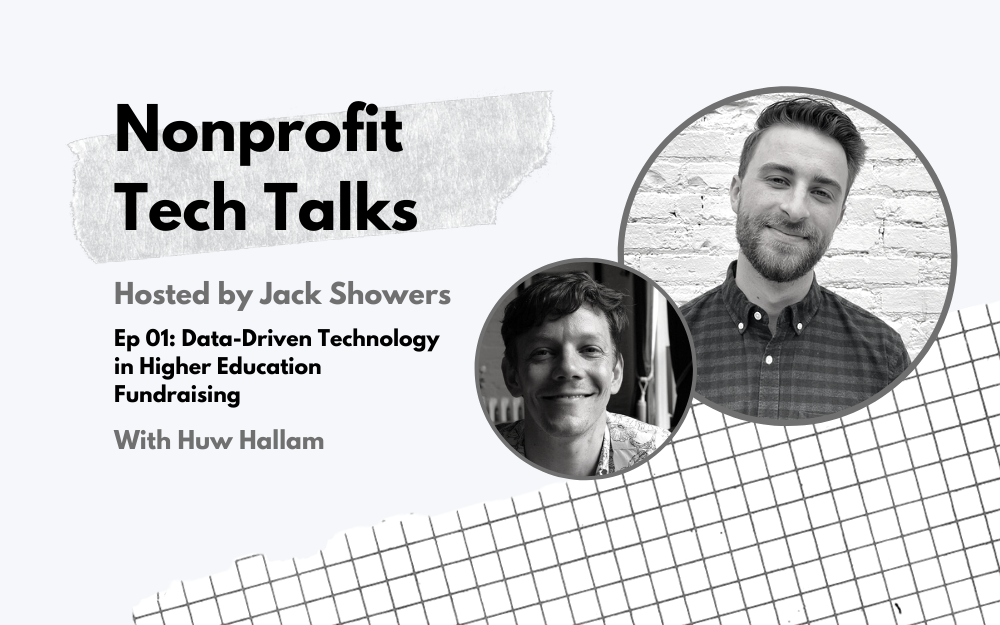In the inaugural episode of Nonprofit Tech Talks, host Jack Showers talks to Huw Hallam, Senior Data and Insights Analyst at the University of Oxford.
Broadly, Jack and Huw discuss how nonprofit professionals, particularly those working in higher education fundraising and development, can take advantage of Artificial Intelligence and data-driven technologies within their work. I’ve highlighted the key topics discussed below.
How Post Secondary Fundraising Changed During the COVID-19 Pandemic
Huw noted that there has been a significant increase in online giving. In fact, nonprofit online revenue grew by 32% in 2020. What’s more, hunger and poverty organizations reported a massive 173% increase in online revenue!
The Investments and Internal Alignments Necessary to Implement AI and Other Data-driven Technologies Into Fundraising
Overall, the widespread adoption of AI within nonprofits is a slow and challenging process, and even most large nonprofits have yet to embrace it fully.
To implement AI within nonprofits, Huw thinks its positive impacts need to be more clearly articulated to upper-level nonprofit managers. However, smaller-sized organizations may not even have the amount of data or resources necessary to implement AI effectively. Additionally, AI requires extensive internal strategizing by nonprofit professionals to determine how they can implement it responsibly.
How Huw Hallam Would Implement AI in His Work
Huw would use AI to analyze donor behavior to create “donor personas.” Segmenting donors by persona type would allow him to craft personalized appeals and donor journeys to develop a more intimate solicitation strategy. Oxford has several hundred thousand alumni, and only AI could personify donors efficiently at this scale.
How Small-to-Mid-Sized Nonprofits can take Advantage of Data-Driven Technology
Invest in data enrichment tools! Third-party databases like iWave and DonorSearch provide fundraisers with additional philanthropic and wealth information to enrich the data they already have. With data enrichment tools, you can make faster and more accurate predictions about a donor’s likelihood to give based on their linkage to your organization, inclination to give, and capacity to give.

Talk to a fundraising expert today to learn more about how Fundraising KIT can quickly and easily help your nonprofit raise more for your cause.
As Technology Frees Fundraisers From Administrative Tasks, What Should They Focus On?
Huw thinks that fundraisers should invest more time into the essential parts of donor relationship building, like designing more complex appeals, being more hands-on with stewardship, and expanding prospect research.
Key Ethical Considerations for Data-Driven Technology
Huw spotlights structural bias as a significant ethical threat to test for and eradicate.
For example, when prioritizing donors by income, a fundraiser can unknowingly exclude female donors, as men tend to earn larger salaries. In this case, a fundraiser would be perpetuating a gender imbalance within society and ensuring their organization is fueled by an unrepresentative sample of their stakeholders.
To combat this issue, keep track of demographic variables and ensure your solicitations do not exclude certain demographic groups.
Huw’s Favourite Data Analysis Technologies
Alteryx is Huw’s “gateway” technology of choice. Its easy-to-use, drag-and-drop design makes Alteryx the platform of choice for data analysis beginners.
Huw suggests using Pandas, an open-source and more advanced data analysis tool if you’re looking for something a bit more advanced.
Huw concludes the interview by urging viewers to start performing more data analysis within their work to gain valuable experience and help them save time and raise more for their mission.

Jack Showers
Nonprofit Research Analyst at Fundraising KIT
When Jack isn’t cheering for the Raptors or watching an 80s action movie, he’s studying the social sector and producing content for nonprofit professionals. As a Nonprofit Research Analyst at KIT, an AI-powered insights and reporting toolkit, he is especially passionate about helping fundraisers save time and raise more money for their cause.







